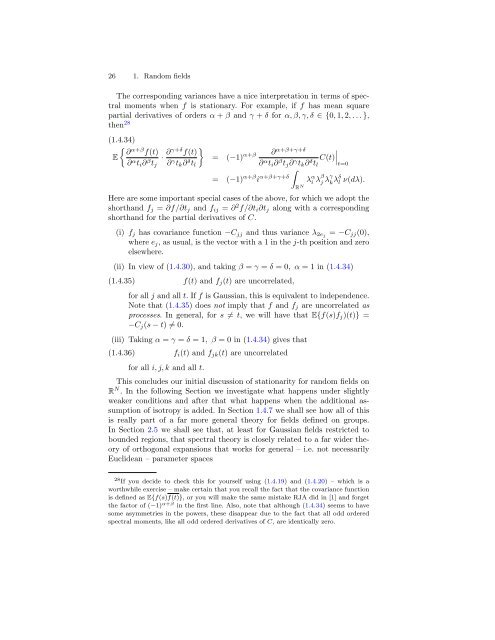Create successful ePaper yourself
Turn your PDF publications into a flip-book with our unique Google optimized e-Paper software.
26 1. Random fields<br />
The corresponding variances have a nice interpretation in terms of spectral<br />
moments when f is stationary. For example, if f has mean square<br />
partial derivatives of orders α + β and γ + δ for α, β, γ, δ ∈ {0, 1, 2, . . . },<br />
then 28<br />
(1.4.34)<br />
� α+β ∂ f(t)<br />
E<br />
∂αti∂ βtj · ∂γ+δf(t) ∂γtk∂ δ �<br />
tl<br />
= (−1) α+β ∂α+β+γ+δ ∂αti∂ βtj∂ γtk∂ δ �<br />
�<br />
C(t) �<br />
tl t=0<br />
= (−1) α+β i α+β+γ+δ<br />
�<br />
λ α i λ β<br />
j λγ<br />
kλδl ν(dλ).<br />
Here are some important special cases of the above, for which we adopt the<br />
shorthand fj = ∂f/∂tj and fij = ∂ 2 f/∂ti∂tj along with a corresponding<br />
shorthand for the partial derivatives of C.<br />
(i) fj has covariance function −Cjj and thus variance λ2ej = −Cjj(0),<br />
where ej, as usual, is the vector with a 1 in the j-th position and zero<br />
elsewhere.<br />
(ii) In view of (1.4.30), and taking β = γ = δ = 0, α = 1 in (1.4.34)<br />
(1.4.35)<br />
f(t) and fj(t) are uncorrelated,<br />
for all j and all t. If f is Gaussian, this is equivalent to independence.<br />
Note that (1.4.35) does not imply that f and fj are uncorrelated as<br />
processes. In general, for s �= t, we will have that E{f(s)fj)(t)} =<br />
−Cj(s − t) �= 0.<br />
(iii) Taking α = γ = δ = 1, β = 0 in (1.4.34) gives that<br />
(1.4.36)<br />
for all i, j, k and all t.<br />
fi(t) and fjk(t) are uncorrelated<br />
This concludes our initial discussion of stationarity for random fields on<br />
R N . In the following Section we investigate what happens under slightly<br />
weaker conditions and after that what happens when the additional assumption<br />
of isotropy is added. In Section 1.4.7 we shall see how all of this<br />
is really part of a far more general theory for fields defined on groups.<br />
In Section 2.5 we shall see that, at least for Gaussian fields restricted to<br />
bounded regions, that spectral theory is closely related to a far wider theory<br />
of orthogonal expansions that works for general – i.e. not necessarily<br />
Euclidean – parameter spaces<br />
28 If you decide to check this for yourself using (1.4.19) and (1.4.20) – which is a<br />
worthwhile exercise – make certain that you recall the fact that the covariance function<br />
is defined as E{f(s)f(t)}, or you will make the same mistake RJA did in [1] and forget<br />
the factor of (−1) α+β in the first line. Also, note that although (1.4.34) seems to have<br />
some asymmetries in the powers, these disappear due to the fact that all odd ordered<br />
spectral moments, like all odd ordered derivatives of C, are identically zero.<br />
R N
















